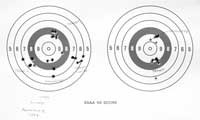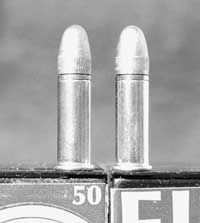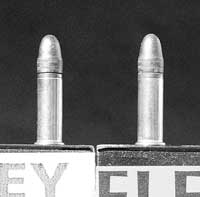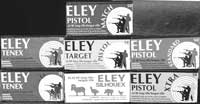Accurate ammo for rimfires
by John Robinson
Handloaders have the advantage of being able to tailor their loads to their specific rifles and squeeze the smallest groups out of what may otherwise be average performers.
 Rimfire shooters do not have the same flexibility, but they have the advantage of having access to a wide range of .22 long rifle rimfire ammunition that covers the full spectrum of indoor target ammo to high velocity game loads and a lot of special options in between.
Rimfire shooters do not have the same flexibility, but they have the advantage of having access to a wide range of .22 long rifle rimfire ammunition that covers the full spectrum of indoor target ammo to high velocity game loads and a lot of special options in between.
It is logical to assume that match ammo will shoot better than standard grades of ammunition and the most expensive match ammunition will shoot better again than lesser grades of target rimfire ammo. However, this is not necessarily so, as the combination of rifle and ammunition has a significant affect on the end result. This also applies to target handguns, although the ability of the shooter to detect ammo variations is limited by the nature of target pistol shooting.
Hardcore match rifle shooters are always looking for superior performance in their .22 match ammo and will acquire specific batches of ammunition that are known to shoot well in their particular target rifle.
The first thing to establish is an accuracy benchmark. If .22 long rifle ammunition is rated as accurate by target rifle standards, it is generally found to be acceptable. While one-hole groups are the desired result, the reality is that ammunition that will consistently shoot sub-12mm groups at 50 metres will satisfy most target shooting requirements.
Good match ammunition will frequently exceed this standard, but shooters have to contend with variables such as wind and personal ability, as well as the absolute accuracy of the rifle and ammo combination.
There are a number of good matches in the SSAA program, such as field rifle, 3-positional, silhouette and rimfire benchrest, that have expanded the requirements for accurate ammunition.
 While top-grade match ammo is available, it can cost up to $20 per box and it still may not deliver the goods in individual rifles. For this reason, it is worth going through a selection process with your rifle to see if one particular type or batch of ammo will produce better-than-average accuracy.
While top-grade match ammo is available, it can cost up to $20 per box and it still may not deliver the goods in individual rifles. For this reason, it is worth going through a selection process with your rifle to see if one particular type or batch of ammo will produce better-than-average accuracy.
In my experience, this frequently reveals a sometimes quite economical brand of .22 rimfire ammunition that will produce exceptional performance in one rifle.
At this point, it is worth reviewing the characteristics of various types of sporting rifles and comparing them to their match-bred relatives.
Given that the rifle's barrel is manufactured to acceptable tolerances, the most critical parts of the accuracy equation are at either end. The chamber is a major determining factor. Rimfire match chambers are tight and are designed to feed the bullet into the rifling when it is chambered. This ensures that the bullet is concentric with the bore and that there is consistent entry of the projectile into the rifling.
Many sporting rifles, particularly autoloaders (not an issue in Australia these days), have chambers designed for reliable feeding and function as a higher priority than accuracy. Bolt actions are more tolerant of tight chambers and some bolt action sporters produce outstanding performance as a result.
The muzzle crown is another important area in determining accuracy. It is possible to cut a rifle's grouping ability in half by having a target style crown put on the muzzle. This ensures that the bullet exits the barrel concentrically and that the high-pressure gases also exit around the bullet uniformly and do not upset the flight of the projectile in that vital millisecond when it is a few millimetres out of the barrel.
A large amount of research has gone into target rimfire ammunition and it is well established that the best velocity for match ammo is just below the speed of sound. Passing through the sound barrier introduces another element of uncertainty into the accuracy equation, yet ammunition that is too slow will raise more issues with trajectory and wind effects.
There is a peculiar phenomenon with rimfire ammunition that does not occur to the same degree with high velocity ammunition. That is, that standard velocity match ammunition is less affected by wind than high velocity rimfire ammo. This does not seem logical, but can be proved mathematically and is a function of the difference between the muzzle velocity and the velocity at the target (velocity loss), rather than the average velocity.
 There are many very good brands of rimfire ammunition available to Australian shooters. In my collection I have Winchester, CCI, Federal, RWS, Lapua, SK, PMC, Fiocchi and Eley. Within these brands there are multiple levels of target ammo from 'club' grade to premium match ammo.
There are many very good brands of rimfire ammunition available to Australian shooters. In my collection I have Winchester, CCI, Federal, RWS, Lapua, SK, PMC, Fiocchi and Eley. Within these brands there are multiple levels of target ammo from 'club' grade to premium match ammo.
In addition to the standard match ammo, special loads for rimfire silhouette shooting are also available, along with a full range of solid and hollowpoint high-velocity ammunition, which can also be found in different performance grades.
The good news about all this is that we have a variety of choices when looking for the right ammunition. It has been my experience that good quality, high-velocity ammunition will frequently shoot better groups out of a sporting rimfire rifle than will top-line match ammo. The chambering of sporters is looser and higher pressures seem to accommodate the tolerances better than the more sedate match loads.
Subtle variations occur in all grades of .22 long rifle ammunition, with respect to the bullet form, and this too can influence the accuracy of the ammunition. Overall bullet length may vary considerably and the location of the driving bands in relation to the case neck will determine how far the bullet needs to travel before engaging the rifling.
The average length of a .22 long rifle cartridge with a 40-grain bullet is close to 25mm. I have measured standard velocity cartridges ranging from 24.3mm to 25.3mm and this variation will have some effect on the way the respective ammunition will perform in individual rifles.
I have a collection of bolt action rimfire rifles, sadly reduced since Port Arthur, that have allowed me to experiment with just about every available .22 rimfire type, with some interesting results. This testing has resulted in some short cuts in sorting a rimfire rifle out that may be of interest.
Rather than shoot the full spectrum of ammo, I initially test the rifle with known, good quality, high-velocity ammo. Winchester Power Point, CCI SG and RWS High Velocity are all consistent performers.
A comparison can then be made with some standard velocity target ammunition. SK Rifle Match, Eley Match or their equivalent will then determine which way the rifle is headed. I have a couple of bolt action rimfires, a Brno among them, that have a preference for the HV ammunition and a number of others that show no performance advantage with higher grades of match ammunition. Some batches of ammunition may 'go off' with time and I have an old batch of Eley Tenex that no longer produces satisfactory results. This is more often caused by oxidation and deterioration of the lubricant on the bullet rather than decay of the powder or primer.
 Target shooters are well aware of these variations throughout time and usually try to use 'fresh' ammunition for their serious competition work. Even travelling on planes can have an effect due to the significant atmospheric pressure changes experienced in air cargo from ground level to 40,000 feet.
Target shooters are well aware of these variations throughout time and usually try to use 'fresh' ammunition for their serious competition work. Even travelling on planes can have an effect due to the significant atmospheric pressure changes experienced in air cargo from ground level to 40,000 feet.
It is worth shooting a significant number of groups once you start zeroing in on a likely batch of ammo. I was recently testing some new Eley Tenex, Tenex Gold and Eley Silhouette ammunition in my wonderfully accurate Anschutz JGA 1422 bolt action sporter. The first groups shot with the Tenex loads were about 12mm at 50 metres in a crosswind, even with my mediocre benchrest shooting skills. The first group shot with the silhouette ammo was larger than 25mm and randomly scattered, so I was ready to conclude that it was not all that happy out of the JGA.
After putting about 20 more shots through the barrel, the silhouette ammunition started to group much better - about 15mm, which, considering it is about half the cost of Tenex, was quite good.
Using a chronograph to monitor load consistency can produce interesting results - not always as expected though. Sometimes, very consistent ammunition, which may not vary more than 20fps from shot to shot, will not shoot as tight a group as ammo with significantly higher shot-to-shot variations.
This again highlights the fact that testing individual brands and sub-types of ammo is the best way to find a pearl in those 'batches of oysters'. By using this process of elimination, I have been able to get each of my bolt action rimfire sporters to shoot consistently smaller than 20mm groups on a still day. The JGA 1422 has shot groups much smaller than 10mm at 50 metres with particular batches of inexpensive standard velocity target ammunition that it has taken a liking to. My Ruger 77-22 particularly likes CCI SG high velocity ammunition and shoots it better than any match ammo, with groups rarely exceeding 20mm at 50 metres.
Most .22 rimfire ammunition is inherently accurate and it should be possible to extract better than 25mm groups out of most bolt action rimfire rifles at 50 metres. If this cannot be achieved, the first thing to check is the condition of the barrel crown, as a fix here is the cheapest option for a big improvement. As long as the bore is in good condition, it may be worth having the barrel re-chambered with a tighter target-type chamber. This is one of the best ways to ensure a measurable improvement in performance.
